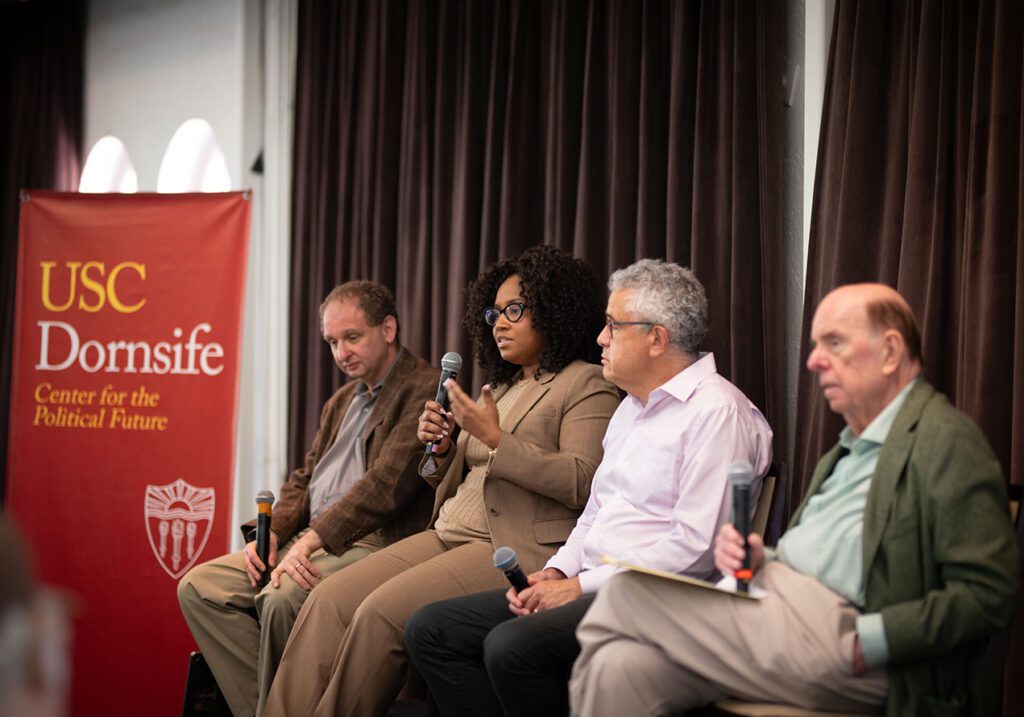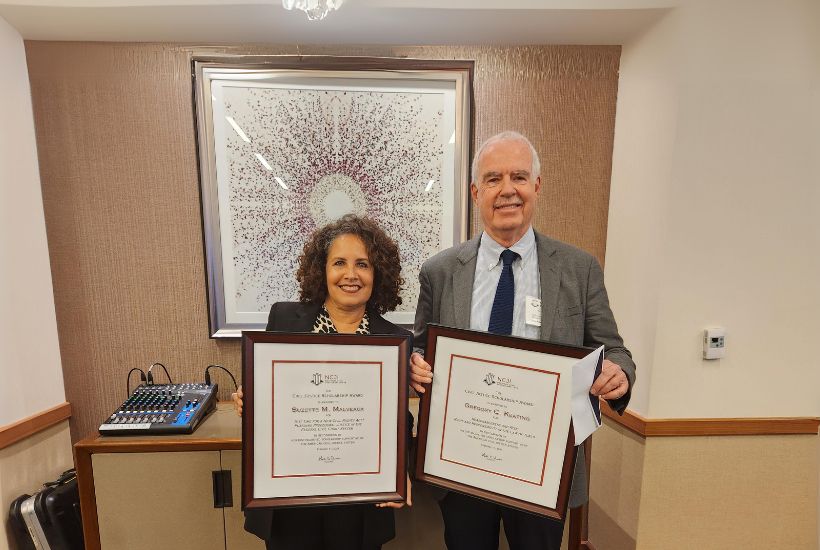You could say Lee Epstein and Rebecca Brown are the odd couple of constitutional scholarship. While Brown’s natural milieu is the reading room, Epstein feels at home on the server farm. Together, the USC Gould School of Law professors make a formidable research team.
“We complement each other,” says Epstein, a political scientist well-versed in quantitative methodology and Distinguished Visiting Professor at USC Gould. “Rebecca is the constitutional law scholar. She can absorb a hundred cases and see how to make sense of the doctrine. I teach constitutional law: I love it. But what I bring to the table is more the ability to spot the signal in the noise.”
Epstein, who is also the Ethan A.H. Shepley Distinguished University Professor at Washington University in St. Louis (WashU), is considered one of the world’s leading experts in empirical legal research, having co-authored or co-edited hundreds of scholarly articles and 19 books in the field. Her background in data analysis is rooted in formal training at Emory University, where she earned her PhD in political science.
Brown, the Rader Family Trustee Chair in Law at USC Gould, brings a theorist’s critical eye to the team. A former law clerk to U.S. Supreme Court Justice Thurgood Marshall, she has published widely in law reviews, focusing on interpreting the Constitution in light of its own principles to protect democracy, liberty and equality. Brown joined USC Gould in 2008, after 20 years as a law professor at Vanderbilt University.
The division of labor goes something like this: “Together we identify problems and questions that come out of the cases,” Brown says, “and Lee figures out how to put our ideas to the test.”
Brown has seen a shift in her own perspectives. Whereas she once explored constitutional law “as a freestanding discipline with its own internal logic,” she now steps back to view the cases also as human artifacts that can reveal overarching patterns beyond the doctrine. “Lee is fierce in following where the data lead,” she says.
Both professors relish the give-and-take of their collaboration.
“When there’s a convergence between the quantitative side and the more thorough, rigorous examination of the opinions that the judges write, that’s the best!” Epstein says. “And if they don’t line up, then you have to figure out why. What explains the mismatch?”
The bedrock that undergirds this cross-disciplinary research is the Supreme Court Database (SCDB). Created in the 1970s by Harold J. Spaeth, a political scientist then at WashU, the searchable system breaks down each case decided by the Supreme Court from 1791 to the present day across 247 variables.
“Who the parties were, what the lower court did, what the Supreme Court did and how each justice voted, the issue-areas raised, the constitutional, statutory or administrative provisions — it’s all there,” Epstein says.
Sharing Results
Epstein first got involved with the SCDB as a professor at WashU in the early 1990s. She spearheaded major overhauls for decades with support from a large National Science Foundation grant and now keeps content current with new decisions.
Helping to update the SCDB are Pennsylvania State University political scientist Michael Nelson and The New York Times Supreme Court correspondent Adam Liptak.
At the close of each SCOTUS term, Epstein and various co-authors prepare a special report for The New York Times outlining key takeaways backed by the numbers. The trends Epstein unearths sometimes inform Liptak’s reporting on the Court.
Their collaboration has borne other fruit. During the Spring 2023 semester, Liptak co-taught a USC Gould intensive course with Epstein, “The Modern U.S. Supreme Court.”
His reporting has drawn attention to Epstein’s and Brown’s paper in Presidential Studies Quarterly, “Is the U.S. Supreme Court a Reliable Backstop for An Overreaching US President? Maybe, but Is An Overreaching (Partisan) Court Worse?,” which caused a stir by upsetting conventional wisdom about the Roberts Court.
“A fundamentally conservative court, with a six-justice majority of Republican appointees that includes three named by Mr. Trump himself, has not been particularly receptive to his arguments,” Liptak wrote in a December 23 article for The Times, citing Epstein’s and Brown’s findings. Indeed, their study exposed the Roberts Court as the most “anti‐president” since Franklin Roosevelt occupied the Oval Office, using cases through the end of 2022, and covering the presidencies of George W. Bush, Barack Obama, Donald Trump, and a year of Joe Biden.
“Should we take this to mean that the Court will be there to protect democracy if an overreaching president tries to trample constitutional limits? Not necessarily,” the researchers noted in their 2023 study, because the data pointed to a partisan or loyalty bias that might come into play in the event that a future encroaching president was of the same party as the majority of justices or had been the appointing president for the swing justices. Those biases may well be at play in the more recent cases involving Donald Trump since he left office. — and that is a question for another study, according to the researchers.
The year before, Liptak drew on the USC Gould team’s data-driven research to report on the rise of an “imperial court” allocating to itself much of the power to oversee and control the two other branches of government.
New Data
Recently, Epstein and Brown have developed a dataset on gun-rights litigation in the federal courts. According to Epstein, it’s likely the most comprehensive collection of data ever amassed on Second Amendment decisions.
Brown and Epstein are already using it for papers probing the effects of the Bruen decision.
In the 2022 ruling (New York State Rifle and Pistol Association v. Bruen), the Supreme Court deemed unconstitutional a New York gun safety law requiring a license to carry concealed weapons in public places. The decision triggered an explosion of gun rights litigation in federal courts, according to Epstein.
“There are some very interesting patterns in the data,” she says, hinting at some of their preliminary findings: “I can tell you that outcomes are more favorable toward the Second Amendment, and that there’s a widening gap between Democratic and Republican judges. Essentially, Bruen has expanded discretion among individual judges.”
Having pioneered the application of big data to constitutional analysis, Epstein is pleased to see her approach catching fire.
“SCDB has served as a model for databases all over the world,” she says. “There are ones for the Norwegian Supreme Court and the Israeli Supreme Court. There are databases for the International Courts, the European Union Court, and many others.”

















